by: Richard S. Phillips, Graduate Student, Texas Tech University
In May 2000, Texas Tech University, with the financial support and assistance of Texas Parks and Wildlife, began the largest study ever conducted on Rio Grande Wild Turkeys. There were three study sites in the Texas Panhandle (Gene Howe Management Area near Canadian, Matador Wildlife Management Area near Paducah and the Salt Fork of the Red River between Hedley and Clarendon--on the Swamp), with a fourth study area in Cimarron National Grasslands in Kansas. At each of the four sites, Rio Grandes were captured, weighed and fitted with leg bands. Some birds (> 200) were also fitted with radio-transmitters that allow each bird to be individually identified. These transmittered birds form the basis of a study to determine survival rates and habitat usage of Rio Grande turkeys in the High and Rolling Plains.
Unfortunately, after five years of study, the Rio Grande Turkey Project was abandoned. Research into wildlife is often done on a piecemeal basis. What is needed, when research is done, is a long term cross species view that will watch changes on a landscape basis. In the scheme of things, one or five year studies have to many uncontrolable variables to be of real value. Yet, the work was interesting and lots of fun.
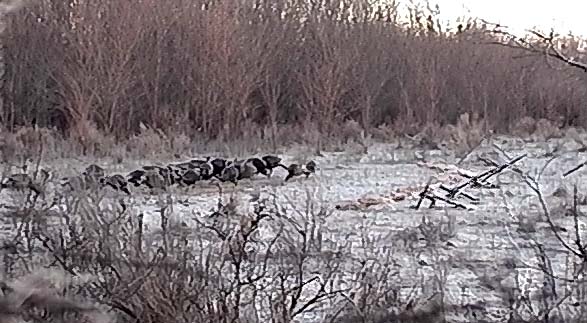 |
| Brain Spears took these photos of the turkeys feeding and the rocket net going off. |
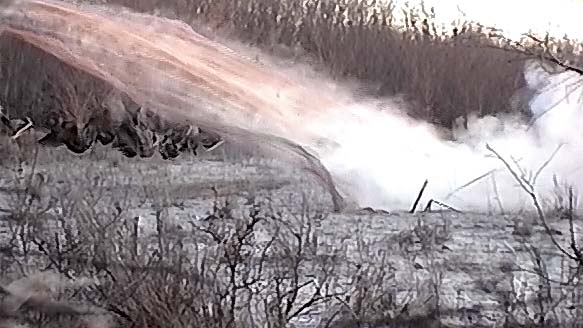 |
Successful trapping season at the Salt Fork From the 21st of January to the 10th of February, personnel from Texas Parks and Wildlife and Texas Tech University trapped and released 148 Rio Grande turkey along the Salt Fork and its tributaries. Turkeys are baited into an area using milo and captured using two types of nets. Drop nets are shaped like a circus tent, with bait placed underneath them. When turkeys come underneath the net, a 22 primer attached to charges on the five supporting poles (one on each corners and one in the middle) is fired and the net drops. Rockets nets are rectangular nets with one end anchored in the ground and the other attached to "rockets" with charges that propel the rockets up and over feeding turkeys. These nets are fired using an electrical current.
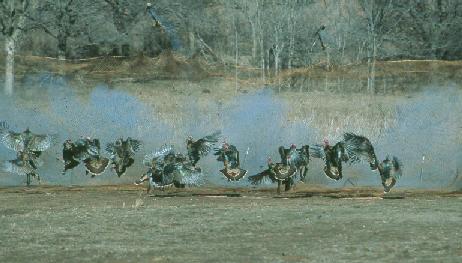 |
Note the rockets at the top, carrying the net over the turkeys as they attempt to fly. These three photos are by John H. Brunjes IV. |
|
|
|
|
|
|
Of the 148 turkeys trapped, 78 were outfitted with radio transmitters. These transmitters weigh about 4 ounces and are attached to the turkey using a cord running under both wings and attached to the transmitter body. The turkeys wear these transmitters like a backpack.
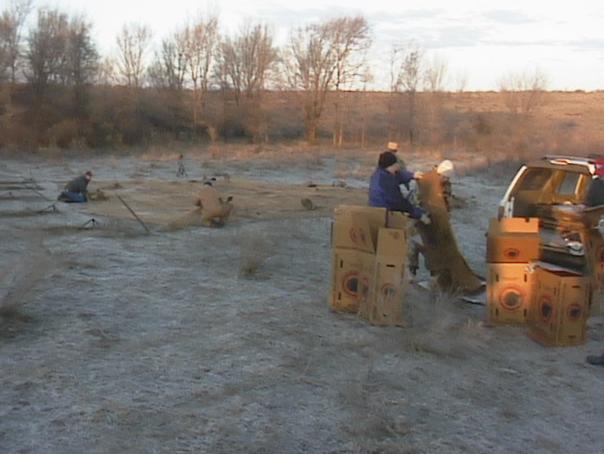 |
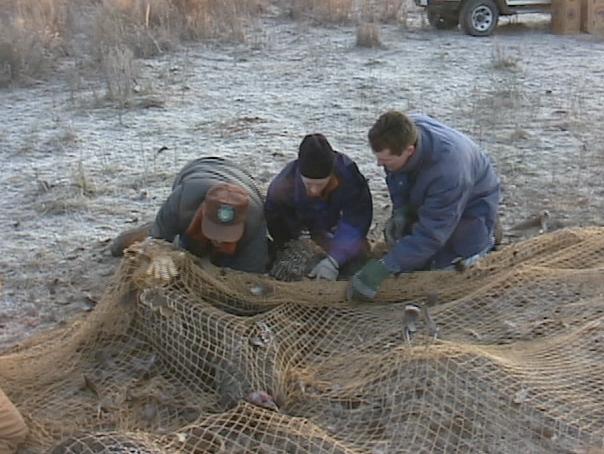 |
| At first light, the rocket trap captures the baited turkeys. Surprisingly, they are immediately calm, once they realize they are trapped. Shipment boxes are set up and the individual birds are moved to the boxes. In the boxes, they are not frightened by activity around them. Below, Brian Spears gently moves a bird. | |
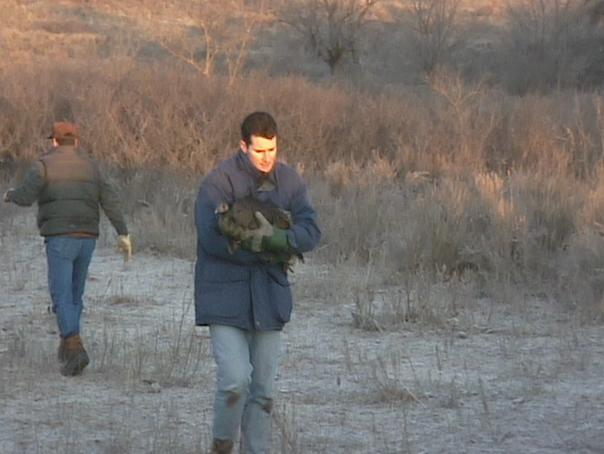 |
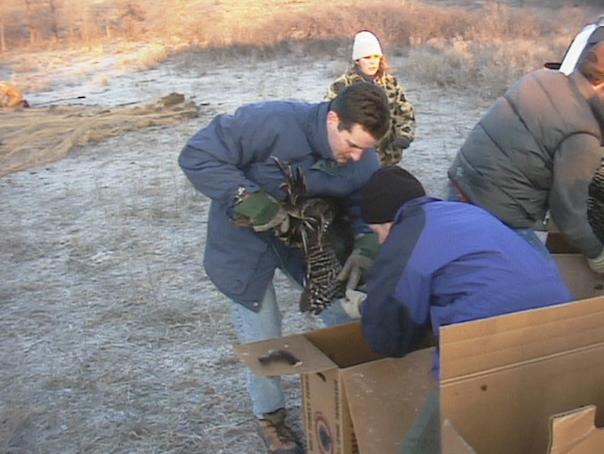 |
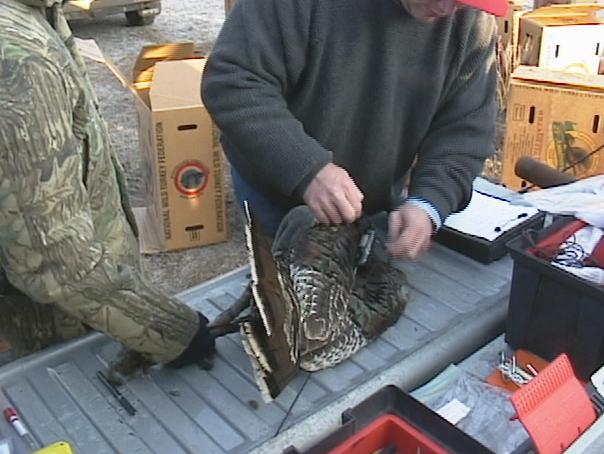
Once all the birds were boxed, individual birds were hooded with socks to keep them calm and John Brunjes placed transmitters on their backs (note the antenna). The researchers also weighed the birds, took their temperature and blood samples. Below is a photo by John H. Brunjes IV showing the transmitter and the sheen of the turkey's feathers. |
A good gobbler |
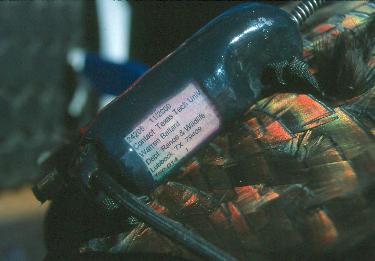 |
|
Every turkey was leg-banded and classified according to age and sex. Females can be told from males by white tips on the breast feathers, a lack of pink skin on the head and neck and the absence of spurs. Males have black tips on their breast feathers, pink skin on the head and neck, spurs and a beard (a few females also have beards). Age classes are determined by the barring on the 9th and 10th wings and the shape of the tail fan. Adult birds have white barring all the way to the tip on the wing feather, while juvenile birds (less than a year old) do not. Adults also have a round tail fan, while the center feathers of a juvenile's tail fan are taller than the rest of the tail feathers.
|
|
|
|
The turkeys are incredibly tranquil while being processed. When Tina Brunjes removes the sock, take off is immediate. |
|
|
|
|
|
|
|
| Many of the birds lightened their load to gain altitude. | |
|
|
|
Day-to day field operations Every transmittered bird gives a specific signal which can be heard with a special receiver (a different "radio station" for each bird). Birds can be located using truck-mounted and handheld antennas. These directional antennas and a compass can be used to locate birds without disturbing them.
During the nesting season, nests will be located on foot using a handheld antenna. For some locations, habitat measurements will be made. We will measure the types of plants present and the amount of cover they provide.
The radio transmitters are also equipped with a mortality switch that changes the signal if a bird has not moved in 8 hours. All mortalities will be investigated dependent upon landowner cooperation.
Each field season will run from January until August. A Texas Tech Masters student under the direction of Doctors Warren Ballard and Mark Wallace of Texas Tech University mans each study area. Seasonal technicians will assist with the fieldwork during the nesting season.
Current turkey behavior During January and February, there were large winter flocks of hens and juveniles of both sexes. There were also groups of between 13 to 16 adult males (toms). The largest winter roost observed contained approximately 250 birds. Around the 2nd week in April, large winter flocks began breaking up with some birds moving as much as twenty miles from the trap site. Evidence of nesting began during the last week of April. On the 27th of April, an adult hen was spooked off a nest of 15 eggs. On the 13th of May, a nest belonging to a juvenile female contained 11 eggs. (Normally, we take compass reading from nearby and do not approach the nest itself. We will rely on eggshells found after the hen has left to determine number of eggs.)
Given an incubation period of 28 days, poults should be present on the Salt Fork during the last week of May to early June. As of May 14, I estimate about 75% of transmittered birds have begun nesting. Soon, we will begin trapping turkey poults and outfitting them with radio-transmitters. These transmitters are tiny, about the size of a Halls cough drop, with an antenna about 4 inches long. At about 2 weeks of age, the poults begin roosting in trees. Until that time, it is estimated that 80% are killed. We plan on doing daily survival rates and will determine cause of death when possible.
Salt Fork by the numbers:
| Age/sex | # radioed | Avg Wt (lb.) | Max Wt | Min Wt | Number dead |
| Adult male | 12 | 17.1 | 18.3 | 15.9 | 3 |
| Adult female | 42 | 9.4 | 10.8 | 7.9 | 4 |
| Juv. male | 10 | 12.4 | 14.1 | 10.4 | 1 |
| Juv. female | 14 | 8.1 | 9 | 7.1 | 3 |
June 2000 Poults on the ground
On May 18, three poults (baby turkeys) were caught and transmittered in the Oklahoma Draw area of the Salt Fork. We have since transmittered two other broods (we transmitter 3 poults per brood - a brood is a group of poults belonging to a hen). The transmittering of poults has not been done often, so a trail run on attachment methods was tried in Lubbock on domestic poults. Based upon the results from this trial, we decided to super-glue the transmitters to the poults. The way we attach these transmitters is quite different from the attachment method used for adults. Using battery-operated clippers, cheesecloth, and super-glue, we shave the back between the wings, put glue on the exposed skin, put down cheesecloth over the glue and then hold the transmitter on the back for ten seconds. On poults, we record weight, number in the brood, capture condition and approximate age. The whole process takes less than 10 minutes per poult.
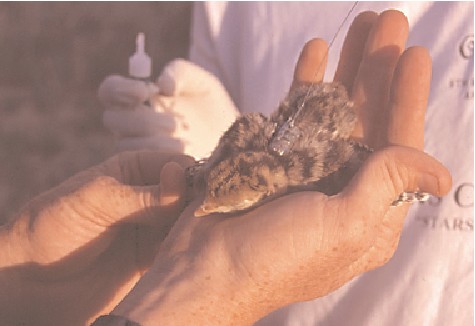 Poult with
transmitter
Poult with
transmitter
(You cannot tell sex on turkeys at this young an age.) These transmitters stay on about 30 days. Though they are much smaller than the transmitters we put on adults, they serve the same purpose. A transmitter allows each poult to be individually identified and located using a receiver and antenna.
In an effort to determine poult survival during the pre-flight period (at about 14 days old the birds start spending the night in trees), our goal is to get poults 1 to 2 days after hatching. Capturing poults at this age takes very careful planning in order to ensure the safety of the birds. 1 to 2 day-old poults weigh about 1.8 ounces (about the weight of 2 AA batteries) and are not able to effectively regulate their body temperature.
If it is too cold, too hot, too damp or too late in the day, we will not try to capture them. To help keep the poults at the correct temperature, we use a small cooler with a water bottle (either warm or cool), even in the best of conditions. We also need to know the number of total poults in the brood, so that at least one is left behind to lure the hen back while we transmitter the others.
Day-to day field operations While we are still getting weekly locations on all of the adult birds, a good deal of effort at this point is directed toward capturing and monitoring poults. Once a hen is close to hatching her eggs (28 days after she begins to sit on eggs full time), we locate her daily. After she has moved off the nest, we inspect the nest to determine if eggs have hatched or not. (Hatched eggs have a circle cut on the fat end of the egg with the inside membrane still attached; eggs that have been preyed on are often crushed or entered from the side of the egg.) If they have hatched, we approach the hen as closely as possible without spooking her. After we are close enough to see the hen, we walk to the spot where she is. The poults remain still and are able to be picked up using your hands (if you can see them). The hen will often try to lure you away from the poults by pretending to be hurt (dragging wings and jumping into the air), though we were "mock-charged" by a hen once during capture. We then transmitter the poults and spook the hen once more, releasing the poults with the other, non-transmittered, brood members.
Salt Fork survival data Available information suggests males (hunting) and females (preyed upon while sitting on nests) suffer the highest mortality in the spring. The Salt Fork data are not complete with regard to specific causes of mortality. We give nesting hens 20 days before we walk in on them (there is little risk of nest abandonment after the hen puts in this much effort). Because of this we lose some information on cause-specific mortality. Some birds are currently labeled "unknown" deaths, the majority of them will probably be classified as predation. At a later time, we will meet in Lubbock and discuss evidence found and make determinations of cause (the folks in Lubbock have much greater experience than I in these matters). I will provide kill characteristics of each predator in a future update.
We have captured and released a total of 78 adult birds. (I will give a rundown on poult mortality in a future update, as these data are still coming in.) Of the predated birds, the breakdown of numbers is as follows: Coyote - 7 (58%); Bobcat - 3 (25%); Hunting - 1 (8%); Unknown predator 1- (8%). There has been no evidence of disease or starvation. 1 adult hen's death was deemed capture-related (she died within one week of capture.).
| Age/sex | # radioed | # alive | # predated | # unknown |
| Adult male | 12 | 7 (58%) | 3 (60%) | 2 (40%) |
| Adult female | 42 | 28 (67%) | 5 (36%) | 8 (57%) |
| Juv. male | 10 | 9 (90%) | 1 (100%) | 0 |
| Juv. female | 14 | 10 (71%) | 4 (100%) | 0 |
Current turkey behavior Poults were first seen by landholders on the Salt Fork on the 17th of May; we aged this brood at 2 days on the 18th. By the 30th , they were flying and roosting in small mesquite trees. (When flying, they look a lot like quail.) Until that time, the hen and her poults had been "roosting" on the ground. Based upon numerous sightings of poults, both untransmittered and transmittered, I believe this brood to be one of the first hatched at the Salt Fork. It appears once the poults can fly, hens start bringing their broods together. Poults of various ages have been observed together on numerous occasions. The largest hen/poult group we have observed contained four hens and more than 20 poults (probably closer to 25 or 30). At this age, instead of sitting tight when danger approaches, the poults fly to the nearest tree.
On the adult side of the things, hens with broods seem to be staying in rather small areas, feeding on abundant grasshoppers. We also have hens that we know have not successfully nested that are roaming widely, compared with their brooding counterparts. It is possible that these remaining hens are attempting to nest, as we have seen increased movement by hens just before choosing a nest site. Further south, hens have been known to nest into mid-July.
Toms and jakes are gobbling and possibly strutting, but at much reduced levels compared with a month ago. Toms (adult males) and jakes (yearling males) are still in smaller groups (2 to 7). I believe the larger groups might be two groups coming together for brief periods. The larger groups are made up of primarily jakes, while lone birds and groups of two are predominately older toms. The toms that were captured in January were apparently several smaller groups that had come together for the winter months. I believe the jakes form their groups as poults in the multi-hen/poult groups. (The battery life on the poult transmitter runs out before the poults are large enough to be fitted with an adult transmitter, so, unfortunately, technology does not allow us to follow a bird continuously from the poult stage to the adult stage.)
Duane Lucia and Richard Phillips box a hen.
Second field season begins
At
the end of the 2000 field season, 42 of the original 78 turkeys that were
outfitted with transmitters were still alive.
First priority upon returning to the Salt Fork was capturing turkeys
while they were still concentrated in large winter flocks.
We began baiting potential trapsites on the 2nd of January.
The snowfall was very helpful in determining potential trapsites as were
landowner recommendations from the previous year.
Beginning on the 15th of January, turkeys were trapped along
the Salt Fork both east and west of Highway 273 Bridge.
We reached our target numbers and concluded trapping on the 3rd
of February. This year, as opposed
to last year, we trapped all turkeys with rocket nets.
Though more dangerous than drop nets, rocket nets seem to be less
intimidating to turkeys, more easily transported and setup, and better able to
trap smaller numbers of specific individuals.
The target numbers for this year were: 35 adult females, 15 adult males,
10 juvenile females and 15 juvenile males.
All turkeys were banded and backpack-style transmitters were placed on
specific turkeys to achieve our target numbers.
With
these target numbers, we had to replace all 25 juvenile birds (juveniles become
adults, for the purposes of this study, when they return to a winter roost –
about 1 ½ years old; for ease of data management, with the beginning of the new
year all previously-captured juveniles were reclassified as adults).
The transmittered birds remaining from last year’s captures were: 31
females and 11 males, all adults for this season.
During the course of trapping, 2 males and 1 female from the previous
year's trapping died. The total
birds targeted for transmitters were: 5 adult hens, 6 adult males and the 25
juveniles. We fired the rocket net
a total of 4 times, twice at two different locations.
Salt
Fork Numbers 2001 Trapping season. #
of recaptures includes both previously banded and transmittered birds.
|
Age/Sex
Classification |
Total
Captured |
Newly
transmittered |
Total
transmittered |
#
of recaptures |
Avg
wgt. (lbs) |
Min
wgt. (lbs) |
Max
wgt. (lbs) |
|
Adult
Females |
48 |
6 |
36 |
10 |
8.8 |
7.5 |
10.1 |
|
Juvenile
Females |
46 |
10 |
8
(2 dead since trap) |
0 |
8.0 |
6.1 |
9.7 |
|
Adult
Males |
15 |
7 |
16 |
3 |
17.3 |
14.6 |
19.2 |
|
Juvenile
Males |
26 |
14 |
14 |
0 |
13.2 |
14.3 |
11.7 |
|
Totals |
135 |
37 |
74 |
13 |
NA |
NA |
NA |
Salt Fork survival data
42 of 78 transmittered birds captured last year survived to January of 2001. These percentages are a bit misleading; special formulas have been developed by biostatisticians that produce more accurate (and in some cases higher) survival rates. Because of the use of the formulas, it makes comparisons between these rates and those found in the literature difficult. In the March or April update I will give “corrected” survival rates and compare them with other reported rates. Since trapping ended on the 3rd, only two turkeys have died. Despite what I feel has been a rather harsh winter, I found no dead turkeys as a result of recent weather events (December snowfall or February ice storm).
Salt Fork survival data for the year 2000
|
Age/Sex |
# radioed |
# alive (%) |
|
Adult Female |
42 |
23 (55%) |
|
Juvenile Female |
14 |
8 (57%) |
|
Adult Male |
12 |
5 (42%) |
|
Juvenile Male |
10 |
6 (60%) |
Day-to-Day field activities
With
sample sizes satisfied, we have begun to collect data again full-time.
Each study bird is outfitted with a backpack-style transmitter that
uniquely identifies each bird. It
also has a mortality switch that changes the signal cadence if the bird has not
moved in eight hours. Mortality
signals are given highest priority in an effort to specifically indicate cause
of death (e.g. bobcat predation, falling brick, etc.).
For each bird, we get at least one location per week.
These locations are obtained using truck-mounted or handheld directional
antennas. We park the truck at a
known location and, using a compass, we take a bearing on the directional
antenna. (Stations, where we park the truck, are assigned numbers and flagged to
increase our efficiency.) Bearings
from three stations will intersect to produce an area where the animal is likely
to be, known as a triangulation. Triangulations
produce a location without affecting the bird’s behavior.
In
an effort to determine habitat use associated with specific turkey behavior, we
will be trying to get visuals on birds as frequently as possible without
affecting the bird’s behavior. We
will be looking for patterns between and among activities (feeding, roosting,
loafing, nesting, brood-rearing) and habitat.
For example, the majority of recent loafing sites here have had open
understories, such as a hackberry grove. Nesting
sites here have typically been in high grasses, with almost no openings in the
understory. We will conduct
extensive study plots that assign numbers to vegetative characteristics.
We can then objectively compare activity specific habitat.
We will also use these data to ground truth a habitat study at a larger
scale. Using GIS (Geographic
Information Systems) technology, Lubbock folks will attempt to determine
landscape-scale habitat changes and their effect on turkey populations across
the Texas Panhandle.
Current
turkey behavior
Currently, large roosts (up to 150 birds) can be found along several of the major drainages in the area. I do not believe any roosts this year are as large as the one last year (>250 birds), but transmittered birds suggest that there are many more roosts out there this year. Large mixed flocks can commonly be found at this time of year. These larger groups appear to be made up of smaller groups, often divided into male and female groups; these smaller groups often feed and travel together. Right now, it appears the hens (both age classes) are most loyal to their groups. Almost like clockwork when I have found a transmittered hen, she is with the same group of birds she was with previously. Groups of females often consist of juveniles and adults and seem to be larger than male groups. While adult male groups are smaller, they are also composed of several groups: a group of 11 birds may actually be 3 or 4 groups. The juvenile males also seem to follow this pattern; however, it appears that juvenile male groups are larger at both levels of grouping, with less consistency among groupings.
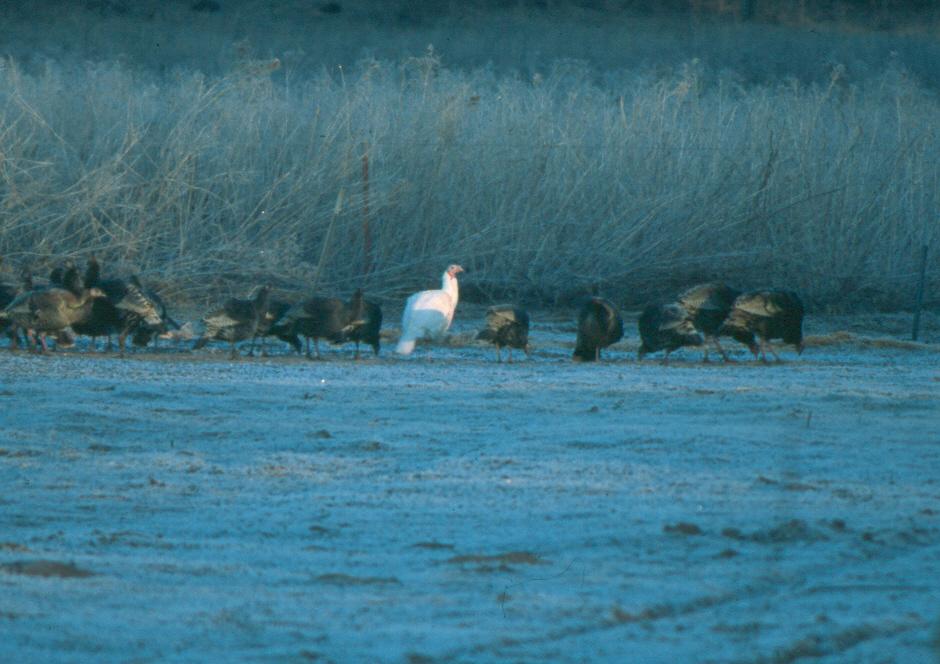
The elusive Moby Turk in the Jog pasture.
Rio Grande Turkey Project
Salt fork update
April, 2002
by: Richard S. Phillips, Graduate Student, Texas Tech University
_________________________________________________________________________________
Trapping Season Successful
For the third year in a row, Rio Grande Wild Turkeys were captured along the Salt Fork of the Red River to form part of a landscape-level study of the subspecies in the Rolling Plains of Texas and Kansas. This year at the Salt Fork study area, 67 new transmitters were put out, bringing the total number of transmittered birds in the area to 85 as of this writing. In an effort to sample each group, transmitters were placed on birds of each age and sex classification. Target numbers for this year were different than previous years because of preliminary findings from 2000 and 2001 (see the section on preliminary movement data). The goal at each of the three Texas study sites was: 20 adult females, 20 juvenile females, 25 adult males and 10 juvenile males. (The Kansas site will monitor birds currently transmittered but capture no additional birds this year.) The numbers for 2002 at the Salt Fork are summarized in the table below. The reason for the larger number of deaths/dropped transmitters compared with other years can be attributed to the increased time I trapped this year: 26th of January to 9th of March. Consequently, these numbers represent birds that died between January 1st and March 9th.
Salt Fork Trapping Numbers for 2002
| Age/Sex Classification | # alive 1/1/2002 | # captured | # newly transmittered | dead or dropped | current # transmittered |
| Adult Female | 19 | 65 | 20 | 5 | 34 |
| Juvie Female | NA | 23 | 21 | 1 | 20 |
| Adult Male | 11 | 19 | 17 | 4 | 24 |
| Juvie Male | NA | 9 | 9 | 2 | 7 |
| TOTALS | 30 | 116 | 67 | 12 | 85 |
Current field work and turkey behavior
The first order of business upon returning to Clarendon from Lubbock is capturing turkeys. Once our turkey quotas were filled, focus shifted to getting locations on transmittered birds. A target of 2 locations per bird per week is the goal throughout the field season. Of particular importance in the winter months is the location of winter roosts that are occupied by transmittered birds. Transmittered birds this year primarily utilized five different winter roosts. Measurements of vegetation around these roosts are taken in an effort to determine relationships between habitat variables and winter roost use. Once the breeding season begins and males begin displaying (around the 15th of March), we begin walking in on birds to determine habitat characteristics associated with specific behaviors, primarily displaying. As with winter roosts, vegetation characteristics are measured at sites where birds have been observed displaying. At about the same time, birds begin moving away from wintering areas, which means increased time spent trying to locate birds in preparation for the onset of nesting.
Preliminary movement data
Analysis of the first two years of data is well under way. One of the primary areas of interest in my aspect of the study is annual movement and differences in this movement among age and sex classes. Rio Grande wild turkeys exhibit movements of larger magnitudes than most other subspecies of turkey. Rio Grandes exhibit seasonal movements, small scale migrations between winter and summer ranges. Males and females begin congregating in large numbers on winter roost areas around the end of September with numbers reaching the peak around the end of October. Females that have successfully reared young bring these juvenile birds back to their winter roost. I believe that these winter roosts are quite stable until the end of the winter, around mid-March. (I cannot be certain of this – we are not currently monitoring juvenile birds between the ages of 30 days and their first winter.) Beginning in mid-March, hens begin moving away from the winter roost to nesting areas. Males appear to follow the females, though some males remain on their wintering grounds year round. At the end of the summer the movement begins anew. The table below summarizes these movements for 2001 wild turkeys along the Salt Fork.
2001 Salt Fork Movement Magnitude Averages
| Type of movement | Adult Female | Juvie Female | Adult Male | Juvie Male |
| Distance from 1st to last roost | 1.048 miles | 8.748 miles | 2.132 miles | 1.952 miles |
| Distance from winter to summer range | 0.688 miles | 6.790 miles | 0.748 miles | 1.384 miles |
| Home range area | 496 acres | 544 acres | 1083 acres | 1119 acres |
The types of movement represent three keys to the spatial use of
habitat by wild turkey. The distance from the first to the last roost is a
straight-line measurement of the fidelity to the winter roost site. The
straight-line distance from winter to summer range is a measure of movement from
the winter area to the breeding area, while the home range areas represent areas
where birds spend the majority of their time. For most birds, this number
represents the area contained in two circles – a summer range and a winter
range.
While these data are preliminary, certain trends are evident. Most striking are the differences between the female cohorts. Juvenile females are traveling much further than adults. An example of this extensive movement can be found in 3 juvenile hens captured just west of the Salt Fork Bridge on McLean Highway. Between roost on the 31st of March and roost on the 12th of April, these 3 hens had moved a straight-line distance of approximately 11 miles (in reality, the path traveled was probably much greater). All three hens established summer ranges near the April roost about 4 miles northeast of Clarendon. Two of these survived to the nesting season, and both attempted nests. Only one hatched poults, neither returned to their place of capture. While this example and the data presented are from the 2001 field season, 2000 data follow the same pattern.
Though these data are consistent with what one would expect with birds, I have found no studies addressing it in the wild turkey. It appears juvenile females are a vital part of population expansion and consequently stability. Three hens successfully producing young could easily turn a winter roost consisting of 15 birds into a roost of 45. I do not have evidence of juvenile hens starting new winter roosts but do not doubt that it could occur.
June 2002 Update
Breeding season mortality
Though there are records of Rio Grande wild turkeys surviving up to 14 years, the majority of turkeys do not make it to their third year. There are currently 9 living birds (2 M, 7 F) that were radio-marked on the Salt Fork in 2000. Both males were captured as juveniles, while 6 of 7 females were captured as adults, making them at least 4 years old. Wild turkey survival is generally not distributed equally across all seasons. While the majority of studies on wild turkey suggest that the breeding season is the time of greatest turkey mortality, there is a great deal of variation in findings with regard to subspecies and latitude of study birds.
While ground roosting, hens are subjected to an increased risk of predation compared with tree-roosting, yet other factors may also play a role in disproportionate mortality documented during the breeding season. The spring hunting season may impact male mortality rates. Additionally, increased understory growth during the spring combined with reduced flock numbers of all cohorts probably increases the odds of a predator getting close without being detected. The tables below represent Salt Fork mortalities by year and cohort for the nesting months. The last column represents the total number dead during that year for each cohort. These simple percentages represent the proportion of annual deaths occurring within a time period.
2000 Salt Fork Breeding Season Mortality Numbers by month
| Cohort | April | May | June | July | Annual Tot |
| Ad Male | 2(29%) | 2(29%) | 0 | 0 | 7 |
| Juv Male | 1(25%) | 0 | 0 | 0 | 4 |
| Ad Female | 1(5%) | 8(40%) | 4(20%) | 1(5%) | 20 |
| Juv Female | 0 | 1(20%) | 0 | 1(20%) | 5 |
2001 Salt Fork Breeding Season Mortality Numbers by month
| Cohort | April | May | June | July | Annual Tot |
| Ad Male | 6(43%) | 6(43%) | 0 | 0 | 14 |
| Juv Male | 0 | 2(33%) | 1(17%) | 0 | 6 |
| Ad Female | 2(12%) | 3(18%) | 2(12%) | 1(6%) | 17 |
| Juv Female | 1(13%) | 1(13%) | 1(13%) | 0 | 8 |
One area of interest in these tables is the difference between the juvenile and adult cohorts, particularly during 2000. While nesting data are still being analyzed, no trends (i.e. decreased nesting rates by juvenile hens) are evident that would explain the difference between the 2000 breeding season morality rates of juvenile (40%) and adult hens (70%). The differences between adults and juveniles in the male cohort may be explained by participation in breeding activities, smaller flocks of adult males compared with their juvenile counterparts, or adult-biased harvest-based mortality. Preliminary data for this year suggest trends similar to 2001 for females and similar to 2000 for males.
Nesting season at the Salt Fork
Roost locations play an important role in identifying hens that are incubating eggs. When nesting begins, hens generally lay one egg per day and return to roost with other birds in trees. After her last egg (ranging from 8 to 21 eggs here on the Salt Fork) is laid, a hen will soon begin full time incubation, sitting on her eggs overnight as opposed to returning to the trees to roost. Consequently, by regularly locating a hen during the overnight hours, it is much easier to predict a hen’s nesting stage. These roost locations also play a major role in determining whether it is safe to flush a hen for an egg count with little risk of abandonment (generally around 14 days). Initiation and incubation dates are calculated using telemetry, hatch dates and egg-floating data to back date start times.
This year we began using “egg-floating” as a tool to further hone our ability to estimate initiation and incubation dates. For egg-floating, a representative sample of eggs (approximately 1/3 of the total clutch) from each nest are placed in a container of water and “floated” to determine the length of time they have been incubated. For example, if two eggs from a clutch float, while two stand upright on the bottom of the container, the hen has been incubating the clutch for approximately 12 days. We are using 26 (range ~ 25 to ~ 29 days) as the average number of days a hen incubates eggs before they hatch. To determine initiation dates, we subtract the number of eggs from the first day incubation started (we are assuming 1 egg per day is laid).
On the Salt Fork nesting has been documented from April through July. The average date of nest initiation (beginning egg-laying) for 2000 and 2001 was the 29th of April. This year, the first radio-marked hen to begin laying eggs did so around the 7th of April, while the earliest documented incubation date was approximately April 21st. The first radio-marked hen to hatch her clutch did so around the 20th of May. As of May 29th, twenty-one first nesting attempts have been confirmed. Several birds are thought to be in the late stages of laying or early incubating on both first and second nest attempts. The most attempts made by a single hen at the Salt Fork was three. The numbers below represent nests documented on the Salt Fork study site for the first two years. The increase in nest numbers between 2000 and 2001 and the decrease in the proportion of successful nests between years are probably an artifact of our increased efficiency in 2001 at finding nests early in the nesting period.
Salt Fork Nesting Numbers for 2000 and 2001
| Year | # of 1st nests | # of 2nd nests | # of 3rd nests | Successful | Avg. Clutch |
| 2000 | 8 | 1 | 0 | 6 | 12.25 |
| 2001 | 20 | 5 | 1 | 7 | 10.79 |
Richard’s Progress!
Richard Phillips, the previous graduate student at this site (also known as Mississippi) has defended his Master’s Thesis! He is nearing completion of his thesis and will graduate this May. His master’s work dealt with juvenile female movements, and the impact of their movements on nesting and survival. Richard is staying on with the turkey project to complete his PhD. We should have literature to send out from Richard early this summer. If you’d like to congratulate him, his e-mail address is Richard.s.phillips@ttu.edu.
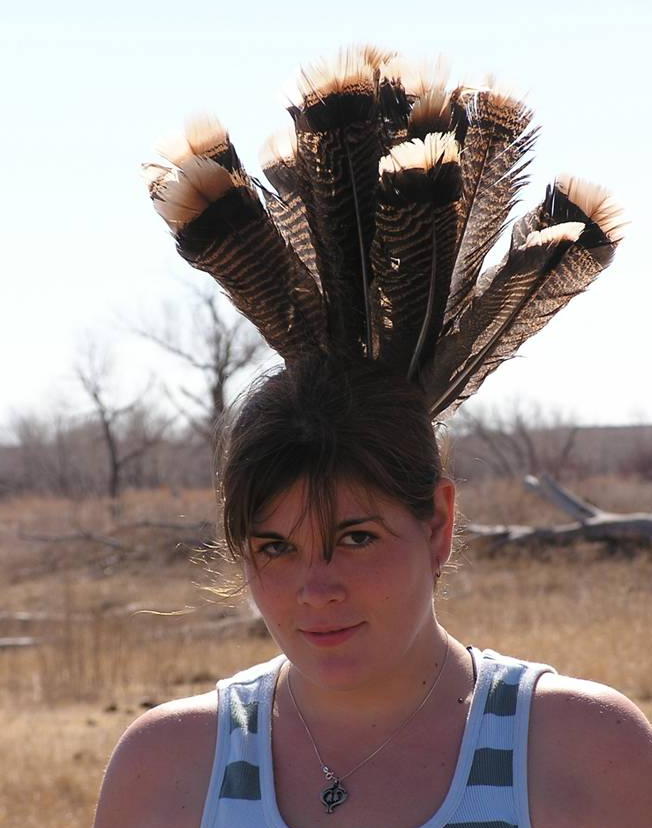
Presently, the study is being run by Rachael Houchin.
Rio Grande Wild Turkey Project
Salt Fork Study Site Update March, 2004
Rachael Houchin, Graduate Student Texas Tech University
Trapping
As of January 1st, 2004, there were 9 adult females and 14 adult males with radio-transmitters that could still be heard at the Salt Fork study site. There are also 7 adult males and 3 adult females who are either lost or have stopped transmitting signals. Trapping goals for 2004 were 75 total turkeys including: 15 juvenile males, 15 juvenile females, 25 adult females and 20 adult males.
We trapped a total of 3 separate times this winter, January 11th and 15th, and February 28th. We baited birds in with milo, and used a rocket net to trap birds. We radio-collared 21 adult females, 7 adult males, 15 juvenile females and 17 juvenile males. This brought our total number of radio-collared individuals in 2004 to 79 (excluding lost birds). We also leg-banded and released (without radio-transmitters) 23 adult females, 3 adult males, 16 juvenile females and 3 juvenile males during the three traps.
Mortality
As of March 18, 2004, 3 adult females, 1 adult male, 6 juvenile females and 7 juvenile males have died. This brings our total transmitting turkeys on March 18 to: 27 adult females, 20 adult males, 9 juvenile females and 10 juvenile males (66 total birds). Most of the mortalities this year (>50%) were thought to be coyote predation. The majority of the remaining birds were unknown cause. Either we found no evidence (only a transmitter) or very little evidence of a bird (a few feathers or some bone shards).
Tracking/Locations
With trapping completed and the season wearing on, we are shifting gears to begin locating turkeys as often as possible. We have located 68 birds a total of 746 times since approximately February 1st. We are also walking in on birds to get exact locations from all time periods of the day. We measure vegetation at the bird locations. During the winter time periods, birds are most active during the afternoon, when it is warm but not hot. Even though they are most active at that time, they still do not move nearly as much as they will in the next two months. During the spring and summer, birds will usually find shady spots to rest during the afternoon, and will be most active in the early morning and later afternoon to evening. We hope by analyzing vegetative characteristics we will be able to identify what makes certain areas in the panhandle have such high concentrations of turkeys (Donley and Collingsworth Counties, for example), while other areas have low concentrations of turkeys (Matador Wildlife Management Area, one of our other study sites, appears to have much lower numbers of turkeys than the Salt Fork study site). By understanding the habitat turkeys need, and what drives turkey movements to new areas, we hope to be able to better manage turkeys across the Texas panhandle.
Roosts
One of our goals during the winter season was to identify and monitor all roosts used by radio-collared birds. We identified 18 roosts used by radio-collared birds during the winter time period (from January 1st, 2004 to approximately March 15th, 2004). These roosts contained anywhere from 13 to 350+ birds. We have two very large (>300 birds) roosts. The majority of our winter roosts contain about 50-100 birds. We have identified 10 additional roosts that have been used during past winter time periods by radio-collared birds, but were not used this season.
We also wanted to locate birds on roost at least every two to three days. We hope to use this information to identify an average date of winter roost break-up. This will allow us to actually define “winter roost” as a time period. We also hope to look at these roosts and determine what makes turkeys roost in certain areas over other areas. This is especially important at this site, where all of our riparian areas are dominated by cottonwood and other potential roost trees.
Movements
The first roost we trapped from had 35 birds transmittered. Within two weeks, none of these birds were found at this roost. However, within the next month, every live bird that had not moved >5 miles had returned to this site. 18 of these birds temporarily went approximately 5 miles east to another roost we trap from. We actually trapped an adult hen at both sites within a two-week time period! 4 birds went approximately 3 miles west of the trap site. 4 juvenile hens went about 10-15 miles north of the site. 2 of these hens have since died.
We expect juvenile hens to move large distances (>7 miles) beginning in early March and ending in May-June. We expect adult hens to move shorter distances (typically less than 6 miles) beginning with nest initiation (mid-March) and ending with nesting season (early August). Juvenile hens typically disperse to new locations, and will not return to the winter roost they moved from. Adult hens typically make a migration during nesting season, moving from a winter roost to a nesting ground and back to winter roost.
Over the past week, we have had a tremendous amount of movement at the Salt Fork. We have tracked 5 adult hens to known nesting grounds from previous years. Turkeys are thought to exhibit nesting site fidelity, especially when previous years’ nests successfully hatch poults. Each of the hens we have followed to previously used nesting grounds was successful in previous years. This could mean these birds are laying eggs already.
Bird Behavior
Winter flocks have begun to break up over the last two weeks. Toms can be seen displaying across the entirety of the study sites. Groups of hens have been caught moving large distances without any males, most likely in search of nesting grounds. It looks like most of our hens are well on their way to nesting. We have a few hens (about 5 out of our 39 current females) that appear to be laying eggs. It is very hard to tell if they are laying eggs, but these hens have been caught each day moving to the same area and returning to the winter roost without other birds moving with them. We will probably find our first hens incubating nests around the first week of April. Hens will lay one egg each day until they have laid all of their eggs. Once they have laid all of their eggs they will stop roosting in trees and spend nights incubating the nest. They will also spend most of the day incubating the nest, but will leave for short times to find food and water each day. We will probably start seeing poults with hens around the middle of May.
Toms
With hunting season beginning this Saturday (April 3rd) and ending May 9th, everyone is excited about the behavior of males this year. Males are displaying and responding to calls across the panhandle at this point. With hens beginning nest initiation over the past week, the males should be getting a little more desperate to hear hens clucking. I had a group of toms gobble back at my truck horn just a few days ago!
NWTF Quarterly Report, June 2004
Salt Fork Study Site
Rachael Houchin, MS candidate, Texas Tech University
There are currently 42 active birds at the Salt Fork study site. Of these there are 15 adult females, 13 adult males, 8 juvenile females and 6 juvenile males. This year we have had 39 total mortalities. The table below summarizes the mortalities this year.
|
Mortalities 2004 |
Cause of Death |
Habitat |
||||||||
|
|
Number |
Kill Site Found |
Canis latrans |
Lynx rufous |
harvested |
unknown /other |
range-land |
riparian |
crop-land |
other |
|
AF |
11 |
4 |
2 |
1 |
1 |
7 |
4 |
6 |
0 |
1 |
|
AM |
9 |
3 |
2 |
1 |
2 |
4 |
2 |
4 |
1 |
2 |
|
JF |
8 |
3 |
3 |
0 |
0 |
5 |
4 |
4 |
0 |
0 |
|
JM |
11 |
4 |
4 |
1 |
0 |
6 |
3 |
8 |
0 |
0 |
|
AF = adult female; AM = adult male; JF = juvenile female; JM = juvenile male |
||||||||||
We have completed just over 100 vegetation plots this year. Of these, 32 have been grid random plots, 46 plots have been centered on turkey locations and 46 plots have been random plots associated with a turkey location. Of the vegetation plots centered on turkey locations, 5 have been brood-rearing plots, 3 were displaying, 14 were loafing, 12 were feeding, 11 were nesting and 1 was roosting.
Nesting this year was slow to start. So far 11 nests have been discovered. Of these 11 nests, 4 were successful and resulted in poults. On average, these hens hatched out 9 poults. These hens, on average, had at least 5 poults when flushed 14 days following hatch. We have also discovered two hens with poults that we did not catch on the nest. One hen had one poult and the other hen had 18 poults along with another hen. Twelve hens have never attempted a nest. Two hens are too distant from the central study site to positively locate them on a regular basis and nesting has not been determined. One of our hens was thought to have nested at one time, but we never caught her on the nest and never found her with poults. Of the nests that did not hatch out, all 7 of them appeared to be depredated. No eggshells were found at 5 of the nests. Two hens were killed on the nest. Of the remaining five hens, one renested and hatched without our realization (she is the hen with one poult), one may be renesting now, two are renesting now, and one has not attempted a second nest. We currently have three hens on the nest. Two hens are expected to hatch early this week and one will be flushed for an egg float this week.
Hunter harvest this year was also slow. From the contact I had with hunters, there were less turkeys seen or responding to calls this year than any other year in memory. We had only two turkeys harvested (compared to six last year). Last year we also lost three toms which we assumed was due to poaching (and leaving the site with the transmitter). This year we have lost no birds at all (though one bird does have a faulty transmitter).
We have already caught birds seeming to flock up in groups of 20 or more, which is very unusual compared to last year. Most of our birds have moved back towards the winter roost, including 6 out of 8 of our juvenile hens. Last year birds did not begin moving back to winter roosting areas until early August.
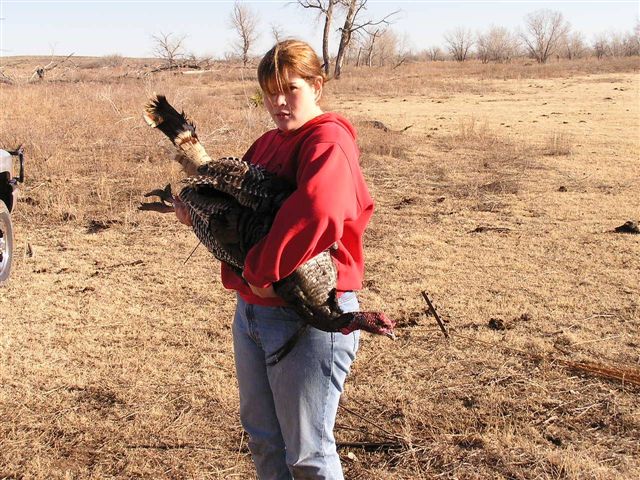
Funding for RGTP provided by Texas Parks & Wildlife Department, the National Wild Turkey Federation and the Texas Chapter Superfund of the National Wild Turkey Federation
Colorado wildlife, Spring Turkey Hunt, Deer hunting, mule deer hog & aoudad hunting, white tail, elk in Colorado, Texas Wildlife, Wildflowers, Texas Tech study, Richard Phillips home page